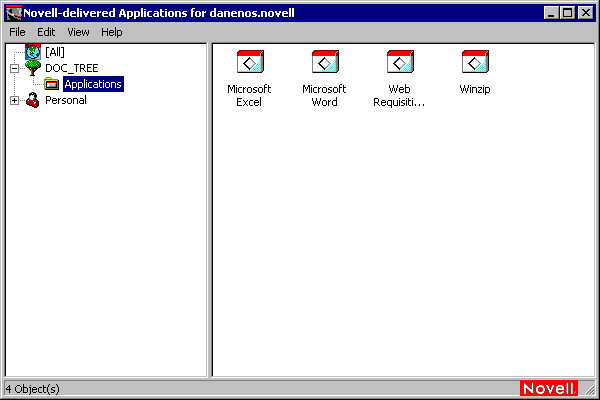19.1 Application Window
The Application Window is a standalone desktop window that provides greater administrative control of the user desktop than the other Application Launcher views.
The following sections contain additional information:
19.1.1 Application Window Description
Figure 19-1 Application Window

The Application Window is divided into two panes. The left pane, referred to as the folder view, displays the following:
-
[All] folder: Contains all applications that have been associated with the user or the workstation. This is an administrator-controlled feature. By default, it is enabled, which means the folder appears. You can disable the feature if desired. For instructions, see Configuring User Settings.
-
eDirectory trees: Each tree contains the applications, located within the tree, that have been associated with the user or workstation. The Application Window displays only the trees to which the user and workstation are authenticated.
-
Personal folder: Provides a location for the user to create personal folders for organizing applications. This is an administrator-controlled feature. By default, it is disabled, which means the folder does not appear. For information about enabling personal folders, see Configuring User Settings.
When a user selects a tree or folder in the left pane, the right pane displays the items (folders or applications) that are contained within the tree or folder.
You can also configure the Application Window to not include the folder view (the left pane).
19.1.2 What Users Can Do with the Application Window
Using the Application Window, users can do the following:
-
Run an application by double-clicking the application's icon in the right pane. Depending on the application and how it is configured in eDirectory, the Application Launcher might install files to the workstation, map drives, or change workstation configuration files or settings.
-
View the properties of an application. The properties include a description of the application, information about people to contact for help with the application, the times when the application is available for use, and the workstation requirements established for the application.
-
Verify (fix) problems with an installed application. Verifying an application causes Application Launcher to redistribute the application to the workstation.
-
Uninstall an application. This is an administrator-controlled feature. By default, it is disabled. You can enable it on a per-application basis. For information, see Section 43.1, Enabling an Application to be Uninstalled.
-
Create personal folders to organize applications. This is an administrator-controlled feature. By default, it is disabled. For information about enabling personal folders, see Configuring User Settings.
-
Log in to eDirectory through the Novell Client™ or the ZENworks Middle Tier Server. This is an administrator-controlled feature. By default, it is disabled.
-
Disconnect Application Launcher from eDirectory so that the user can work offline. Disconnecting Application Launcher from eDirectory does not log the user out of eDirectory.
19.1.3 Why Use the Application Window?
The Application Window provides greater administrative control of the user desktop than either of the other two views. You should use this view if you want to partially or completely lock down user workstations.
For example, the Application Window lets you ensure that all distributed applications are located only in the Application Window. At the same time, you can also determine the way the applications are organized in the window.
Or, if you want even greater control, you can replace the Windows desktop with the Application Window. This lets you restrict user access to only the applications in the Application Window. For instructions, see Using Application Launcher As the Windows Shell.